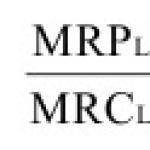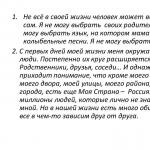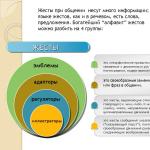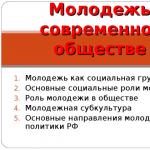Management of development of design and estimate documentation. Appius-PLM Management of design and estimate documentation Management of development of project documentation
Over the life cycle of a typical project, a project manager may create up to fifty different types of documents to facilitate project planning, tracking, and reporting. Documents range from feasibility studies, resource plans, financial and project plans to contracts with suppliers, system performance reviews, change request forms and project status reports.
The way in which a project manager manages project documentation can be a direct cause of the project's success or an obstacle that degrades the project's health and causes it to fail to meet its timeline, budget, and scope.
This article describes an effective document management strategy for project managers and its practical impact on improving your understanding of project status so you can better respond to the inevitable changes that occur in your day-to-day work.
The role of project documentation
The main job of a project manager is to manage surprise. The concept of planning, by its nature, is designed to reduce and manage surprise. Most project managers would agree that project documentation, as part of the planning process, plays a central role in the strategic development of the final plan and the effective communication of project progress and status changes to all stakeholders. Moreover, the method by which project documentation is managed determines the effectiveness of the project manager's response to the unexpected.
Before discussing project documentation management, let's define "project documentation" and how it fits into an organization's typical project management workflow. A project document is a complete (stand-alone) document that details the specific activities of an organization in initiating, planning, executing, and completing projects. The types of project documents you choose, the format in which they are created, and the method by which they are organized are essentially what differentiate your project delivery organization. Experienced project managers have become adept at creating templates for project documents. Reuse of successful project plans, complex business case documents, standard contracts, detailed specification sheets, and project status reports are necessary to effectively compensate for the project manager's unmanageable documentation that prevents him from focusing on his core competencies of managing the project and its stakeholders. However, a project template is only as good as the individual manager using it. What separates excellent project managers from good project managers is their ability to reduce their administrative role in creating project documents while maximizing their strategic role in managing the people who deliver a successful project. To achieve this, project managers must follow some basic rules in developing master project documents that describe all phases of the project life cycle.
Although project document management may vary from organization to organization, good project managers will develop a number of key project documents to maintain high project delivery standards. Documentation standardization can usually be seen in the following project phases:
- Description or concept of the project: In this phase, the basis of the project charter is created. Defining the charter and details surrounding the project's goals is key to ensuring the project's success.
- Project planning: In this phase, project management plans for the unexpected. Documents outlining the project plan, resource allocation, client agreements, and risk management contain the strategic details of the project.
- Project implementation: In this phase, monitoring and reaction are key. Project documents provide real data and updates to the project plan. Tracking of costs, time, work performed, and problems encountered are documented in this phase.
- Closing the project: In this phase, documents outline outstanding issues and/or deliverables, an overview of the project's outcome, and best practices that project management will apply moving forward.
These project phases are indicators of what types of documents play an important role during the project life cycle. The following sections will describe the obstacles created by a poor records management strategy and how these problems can be resolved with the right strategy.
Confusion in documents
“Stationery rat!” “Bureaucrat!” - these are the last words with which the project manager would like to be noted. Inept project managers can easily fall into the trap of creating piles of paperwork, which can dull their judgment and lead to inevitable project failure. If project documentation is poorly managed, it can easily hide the real state of the project, create confusion and frustrate those who need answers, as well as those who need the project to be delivered. Improper use of project documentation can minimize the strategic importance the project manager has to the project's outcome. For this reason, identifying problems in project documentation is as important as using project documents effectively.
The reasons for this difficulty lie in the conventional method that many organizations use to handle project documentation. Many organizations do not have a documentation strategy that ensures the integration of information and the flow of project documents among project stakeholders. As a result, poor project documentation management produces the following symptoms:
- Lack of clarity: Project managers and stakeholders have a vague understanding of the status of the project and all the work involved. Project documents are considered as separate pieces of information, between which there is no exchange of information. These documents lead to an excess of information that provides a lack of clarity.
- Weak security: Poor security means there are no business rules or workflows for handling important documents. This can result in important project information ending up in the wrong hands, completely defeating the project's goals.
- Data loss: Many project managers don't have processes or the ability to store all project documentation in one repository. Information in these documents can potentially get lost, become difficult to access, and lead to a lack of data integrity, potentially leading to incorrect reporting of decision making.
- Limited cooperation: Project documents (such as spreadsheets) are often managed as unstructured data stored in emails, desktops, and paper formats. For the most part, project documents cannot be easily distributed among project stakeholders who may need to access information from multiple locations.
Identifying document management issues is the first important step to eliminating document clutter in your projects. The next step is to implement best practices developed by project management experts whose job is to streamline document management.
Utopia of Documentation
In an ideal world, project managers would be able to capture the smallest details in their project documents and still be able to extract the most important information when needed. Before implementing a document management strategy, project managers must get into the role they play as "knowledge workers." What is a knowledge worker?
“Every knowledge worker in a modern organization is a performer if, by virtue of his position or knowledge, he is responsible for making contributions that materially affect the organization’s ability to perform work and produce results.” Peter Drucker in The Effective Executive (1966).
With the understanding that project success is inextricably linked to the project manager's ability to extract the most relevant information from the project documents created to make informed decisions, document management no longer plays a supporting role in the daily work of the project manager.
With this in mind, experts in enterprise content management strategies and document management are applying best practices in storing, managing and tracking documents and reports to enable organizations to develop "knowledge workers" who are at the center of their organizations' operations.
Below are a few elements of best practices found in the document management world that project managers can implement:
- Collection of documents: Ability to efficiently store electronic and paper documents of various formats in a central repository. Document collection is not only about storing information in an organized manner, but also about the ability to easily extract significant information from documents and from historical records.
- Version control: the ability to provide check-in and check-out options and provide different levels of security, such as read and write access, to ensure the integrity of the data contained in stored documents.
- Technological processes: the ability to create and apply custom workflows that align with your organization's business processes and approved workflow.
- Reporting and analysis: The ability to share information between documents, as well as summarize data across multiple documents for reporting and analysis to provide greater understanding (clarity) within your organization.
- Cooperation: the ability to distribute documents to appropriate stakeholders, as well as limit access to documents to people who should not have access to them.
These best practices are even more important to the project manager, whose typical workday revolves around project documents created to generate the added value that comes from successfully completing a project through them.
Project documentation management is a process that takes place in all design organizations. The term “technical document flow” is often also used to describe it. It has much in common with the usual “administrative” document flow: documents follow a given route during development, verification and approval.
Project documentation management system
The tools offered by the ESG Bureau for solving problems of project documentation management take into account the features of the project documentation management process and have a number of distinctive details. When building a project documentation management system, the following must be taken into account:
- In design organizations, what is more often of interest is the “movement” not of a single drawing, but of a volume/set with all text, spreadsheet documents and drawings;
- When managing design documentation in the process of making changes, in addition to the new version of a specific drawing, the version of the structure (composition) of the entire main set is of interest. At the same time, it is often necessary in design organizations to store not only versions of all documents, but also versions of the composition of the main sets: initial, existing at the time of each change, current;
- Project documentation management is closely related to the automation of the movement of project tasks between related departments, in other words, the process of “task exchange”. At the same time, along with the design tasks, the initial data, intermediate solutions for tasks, and kits “move.” The process of issuing and exchanging project assignments is one of the most difficult to automate;
- There is often no clear line between the flow of documents (DocFlow) and the flow of work and tasks (WorkFlow). For example, in some organizations, a project task is considered as a work to which certain initial data - documents - are attached. The result of such work is intermediate design solutions and documents. In some design organizations, a design task is “not only work”, but also a document drawn up in accordance with the requirements of the organization’s standard. The movement of such a document should be ensured by the project documentation management system;
- Our experience shows that in order to typify and unify design processes, it is always advisable to work on standardizing the flow of design documents and tasks. In the presence of such standardization, the preparation of appropriate documents for the quality management system of the design organization, and the implementation of a design documentation management system, the degree of automation of processes and, as a consequence, their productivity increases sharply;
- Due to the fact that documentation development tools - CAD, calculation packages, text editors - constitute a single environment, the design documentation management system must have means of interface interaction with them. However, such tools, as a rule, are not intended to obtain engineering data from content for subsequent processing, which is one of the functions of . Interface interaction in the project documentation management system mainly performs auxiliary service functions that allow for a greater degree of automation. An example is the automated reading of corner stamp field values from an AutoCAD drawing and subsequent recording of them into the fields of an electronic drawing card.
Platform for building a project documentation management system
ESG Bureau offers the construction of a project documentation management system on the software platform
Our company has extensive experience in developing project documentation management systems and electronic technical archive systems. Examples of the most large-scale implementations include the supply of software, development, implementation and necessary support of the project documentation management system at OJSC Giprospetsgaz, CJSC Central Research Institute of SM, OJSC Krasny Oktyabr and other design organizations and industrial enterprises.
ESG Bureau services for building a project documentation management system
The ESG Bureau company offers a full range of services in this area: consulting, surveys, development of technical specifications, system implementation, user training, development of operational documentation and participation in the standardization of automated processes for managing project documentation, support and development of implemented solutions. In their activities, our highly qualified specialists use the company’s many years of experience, standards (in particular GOST 34.xx) and the most modern tools and methods for conducting business analysis when setting a task, advanced programming tools when developing subsystems, proven methods of training, implementation and maintenance of management systems project documents.
Composition and procedure for developing project documentation. The construction of facilities is carried out on the basis of approved justifications for investments in the construction of enterprises, buildings and structures. The design documentation details the decisions made in the justifications and clarifies the main technical and economic indicators. Project documentation usually includes a construction feasibility study and working documentation.
The procedure for the development, coordination and approval of design documentation for the construction of buildings and structures is regulated by SNiP for technically and environmentally complex objects, and under special natural construction conditions, by decision of the customer, or the conclusion of a state examination, additional detailed elaborations of design solutions can be carried out simultaneously with the development of working documentation and construction. on individual objects, sections, issues.
For objects being built under mass and reuse projects, as well as other technically simple objects, a detailed design can be developed based on justification for construction.
The main document regulating legal and financial relations, mutual obligations and responsibilities of the parties is the contract concluded by the customer with the design, design and construction organizations, other legal entities and individuals attracted by him to develop project documentation. An integral part of the contract must be a design assignment.
Development of design documentation is carried out in the presence of a decision on preliminary approval of the location of the facility, on the basis of approved justifications for investments in construction or other pre-design materials, contracts and design assignments.
Project documentation is developed primarily on a competitive basis, including through contract tenders.
Project documentation developed in accordance with the initial data, technical conditions and requirements issued by state supervisory authorities and interested organizations when agreeing on the location of the facility is not subject to additional approval, except in cases specifically provided for by the legislation of the Russian Federation.
The design of construction projects must be carried out by legal entities and individuals who have received the right to the corresponding type of activity in accordance with the established procedure.
The use of inventions in the design of construction projects and legal protection of inventions created in the process of developing project documentation
Bidding for the development of project documentation. The procedure for organizing and conducting a tender for design work is determined by the investor in accordance with the Regulations on contract bidding in the Russian Federation by a series of methodological recommendations approved by the Interdepartmental Commission on Contract Bidding.
A tender for the design of an object can be held for part of the design documentation: feasibility study, preliminary design, working documentation, the entire volume of design documentation.
Working documentation. Detailed documentation for the construction of enterprises, buildings and structures is developed in accordance with state standards and is specified by the customer and the designer in the design contract.
Reference documents are not included in the working documentation and can be transferred to the customer if specified in the contract.
The customer provides the design organization with initial materials: investment justification; decision of the local executive authority on preliminary approval of the location of the facility; the act of selecting a land plot for construction and the materials attached to it; architectural and planning assignment drawn up in accordance with the established procedure; technical conditions for connecting the designed facilities to supply sources, engineering networks and communications; information about discussions held with the public regarding decisions on the construction of the facility; initial data on equipment, including individual production; data on completed R&D; investor materials, appraisal reports and decisions of local administration bodies on compensation for demolished buildings and structures; materials received from local administration and state supervisory authorities regarding the project environment and the state of the natural environment; materials from engineering surveys and surveys, measurement drawings of existing buildings and structures at the construction site; drawings and characteristics of the enterprise's products; assignment for the development of tender documentation; conclusions and materials made based on the results of inspection of existing production facilities, structures of buildings and structures.
Accuracy of cost estimates. At each stage of the project, a cost estimate is made. In large foreign projects, at least four types of estimates are prepared with increasing degrees of accuracy: preliminary assessment, which aims to assess the viability of the project with an acceptable estimate error of 25-40%; primary or factor, aiming to compare planned costs with budget restrictions. Permissible estimation error 15-25%; approximate, intended for preparing a project financing plan with an acceptable estimation accuracy of 10-15%; final, intended for the preparation and conduct of tenders with an acceptable estimation error of 5-6%.
Management of development of design and estimate documentation. Design work is carried out in the following sequence: selection of designers and conclusion of contracts based on the results of the competition; planning of design and estimate works and services; actual design and approval of design and estimate documentation.
The organizational forms of design firms are very diverse and can be reduced to the following types: design and construction firms that carry out the full range of work on design, configuration, construction and commissioning of facilities; design institutes that carry out the full range of works on designing objects, including all types of engineering and architectural tasks and tasks on planning development areas. Typically, such institutes specialize according to industry; design institutes specialized on a technological basis. Such institutes can be divided into three types: those specializing in the initial phase of the project; providing multifaceted services to customers who need assistance on complex and special engineering issues; developing the organization and technology of construction production.
The customer must reach an agreement with the licensor - a legal entity or individual who has the exclusive right to industrial use of the technology that is planned to be used in the project.
Selection of design firms. There are three approaches to how clients select design firms: Providing professional services as needed. In this case, the customer resorts to the services of a design company on the basis of a special agreement without a competition; closed negotiations. If the design firm is already performing work for the customer, then it is instructed to prepare proposals for a new project, conducts an examination of these proposals and concludes an additional agreement to the contract; holding a competition. In this case, the following types of commercial agreements between the customer and the contractor are possible: payment based on actual costs; payment with an upper price limit; fix price.
The functional responsibilities of design firms are divided into two parts: typical, which include: preliminary design; detailed design; development of estimates; author's supervision; additional, including: preparation for auctions and assistance in their conduct; design analysis; development of investment justifications and feasibility studies; participation in project management; preparation of financing, group functions. The next stage in organizing design and survey work is their planning. This plan is a dynamic document that requires numerous revisions and refinements throughout the project life cycle. The plan must contain: a general description of the work to be performed, with a mandatory indication of the procedure for interaction with other project participants. This description is drawn up in the form of a schedule; the procedure and frequency of monitoring the progress of design and survey work; requirements for the plans of subcontracting firms working on design and estimate documentation.
Functions of a project manager.
At all stages of development of project documentation, the leading role belongs to the project manager. During the design process, the project manager performs the following functions: monitoring the compliance of the volume and timing of the work performed with the required minimum, provided for by the contract, selecting and attracting leading specialists in engineering disciplines to the project, coordinating their activities - determining rational deadlines for the start of work in order to avoid premature completion; adjustment of the number of employed workers; control over changes to the project; control over factors, conditions and documents that may increase the cost of work; checking compliance with the sequence and priorities chosen during the work planning process; ensuring the preferred choice of standard materials and equipment in the maximum possible number of situations, ensuring a minimum range of products used; preparation and implementation of an agreement with the licensor; preparation and monitoring of compliance with the design work plan, linked to the overall project plan; development of design assignments together with the customer.
Depending on the scale and complexity of the project, the functions of a manager at the design stage can be assigned either to the manager of the entire project or to a specially appointed project manager working in a team under the leadership of the main manager.
Automation of design work.
Leading Western and, to a lesser extent, domestic design firms made the transition from computerization of individual, most labor-intensive types of work to computer-aided design (CAD) systems covering the entire process of creating a project. However, the creation of CAD must be preceded by a thorough economic analysis. Experience shows that for small and medium-sized companies it is more profitable to use the services of third-party specialists than to create their own system with a staff of specialists.
The main issues that must be resolved when implementing CAD include: adapting the organizational structure of the company to the requirements of CAD, the essence of which is to organize information flows in such a way as to avoid duplication of data among various participants in the design process; selection of software and computer equipment, taking into account the fact that they are updated every 5-6 years; resolving the issue of the structure of the data bank used in the system. In general, the data includes information on specific materials consumption, cost, layout solutions, technology, construction time, as well as standards and standard design solutions. Working effectively in many countries around the world is the universal CADAD system with elements of artificial intelligence such as CAD/CAM, which is an integrated automated system for design, design, analysis and project management.
This system can be roughly divided into two parts. The first is intended for designing objects and consists of: a layout design subsystem with two- and three-dimensional graphics blocks; subsystems for design and analysis of the construction part of the facility with the generation of drawings; subsystems for designing and analyzing the technological part of an object with the generation of drawings; subsystems for calculating the need for material and labor resources with an estimate in man-hours. The second part provides management of project activities and includes: a management system; quality assessment and control system; project document flow system with its own database.
The CADAD interface is connected to the system used for scheduling.
The system provides a quick response to requests, as well as flexible and effective methods of protecting information from unauthorized access. Graphic data can be accompanied by text notes that can be edited.
At the output of the program, the user receives three models: a new two-contour drawing of walls with detailed drawing of door and window openings, a plan with hatching superimposed on it, and a text file containing information about the facts and reasons for unsatisfactory execution of the program, indicating errors in the drawings.
The library of standard parts and symbols contains approximately 1,200 graphic elements and structural parts that can be transferred to shop drawings. Parts from the library can be used in their original form or modified to suit the specifics of the project.
The AUTOCAD system is a professional computer-aided design and drawing system, the operation of which is based on the use of inexpensive microcomputers used even in a small design office or department. The AUTOCAD system allows you to complete the work in a shorter time. Its users complete drawings two to three times faster than traditional methods, and the system pays for itself many times over in use.
In recent years, expert systems have become increasingly widely used, representing a new stage in the growth of the intelligence of automated systems, developed to a level at which a variety of facts and data create the possibility of new information emerging, similar to how a person does it.
Design work is carried out in the following sequence: selection of designers and conclusion of contracts based on the results of the competition; planning of design and estimate works and services; actual design and approval of design and estimate documentation.
The organizational forms of design firms are very diverse and can be reduced to the following types: design and construction firms that carry out the full range of work on design, configuration, construction and commissioning of facilities; design institutes that carry out the full range of works on designing objects, including all types of engineering and architectural tasks and tasks on planning development areas. Typically, such institutes specialize according to industry; design institutes specialized on a technological basis. Such institutes can be divided into three types: those specializing in the initial phase of the project; providing multifaceted services to customers who need assistance on complex and special engineering issues; developing the organization and technology of construction production.
The customer must reach an agreement with the licensor - a legal entity or individual who has the exclusive right to industrial use of the technology that is planned to be used in the project.
Selection of design firms. There are three approaches to how clients select design firms: Providing professional services as needed. In this case, the customer resorts to the services of a design company on the basis of a special agreement without a competition; closed negotiations. If the design firm is already performing work for the customer, then it is instructed to prepare proposals for a new project, conducts an examination of these proposals and concludes an additional agreement to the contract; holding a competition. In this case, the following types of commercial agreements between the customer and the contractor are possible: payment based on actual costs; payment with an upper price limit; fix price.
The functional responsibilities of design firms are divided into two parts: typical, which include: preliminary design; detailed design; development of estimates; author's supervision; additional, including: preparation for auctions and assistance in their conduct; design analysis; development of investment justifications and feasibility studies; participation in project management; preparation of financing, group functions. The next stage in organizing design and survey work is their planning. This plan is a dynamic document that requires numerous revisions and refinements throughout the project life cycle. The plan must contain: a general description of the work to be performed, with a mandatory indication of the procedure for interaction with other project participants. This description is drawn up in the form of a schedule; the procedure and frequency of monitoring the progress of design and survey work; requirements for the plans of subcontracting firms working on design and estimate documentation.
Design and architectural and construction organizations are currently actively moving to the development of project documentation in electronic form. Of course, this process must be coordinated, and the documentation thus obtained must be stored and processed.
The PartY PLUS system allows you to automate almost all tasks related to document management in design and architectural and construction organizations.
PartY PLUS meets the requirements of domestic standards (SPDS, ESKD, etc.) and at the same time is focused on supporting international standards (ISO 9000, STEP).
PartY PLUS allows you to quickly import existing electronic drawings and other developments into the enterprise’s electronic archive system. At the same time, it is possible to simultaneously maintain an electronic file cabinet of paper documents.
The PartY PLUS delivery set includes an example of settings for the document accounting system in accordance with the requirements of the SPDS. Documentation is stored for projects in a structured form (Fig. 1). For each electronic or paper document, an accounting card is created containing the necessary set of attribute information, which can later be used to search and classify documents. This setting can be easily modified without programming, according to the needs of a specific customer.
The document storage system can be either centralized or geographically distributed, without any restrictions on storage volumes or the number of users.
Management of project documentation at various stages of development
PartY PLUS allows you not only to store already developed documentation, but also to manage the process of its development. In this case, the documentation can be structured directly at the stage of its creation.
The structure of project documentation can be presented from various points of view. In Fig. Figure 2 shows a fragment of the structure of project documentation related to the “RD” stage. The figure shows that a diesel power plant (diesel power plant facility) is being designed at field No. 3. When designing a diesel power plant, one of the elements is the building of a diesel station. This building is number 7 on the general plan, as can be seen from the description of the object. The screen form called “Object” displays a set of attributes that characterize the design object.
In addition to purely design characteristics (name, code, number according to the general plan), the form uses dates that allow dispatching the process of design work, planned and actual dates for the start of documentation development, as well as planned and actual dates for the completion of documentation.





